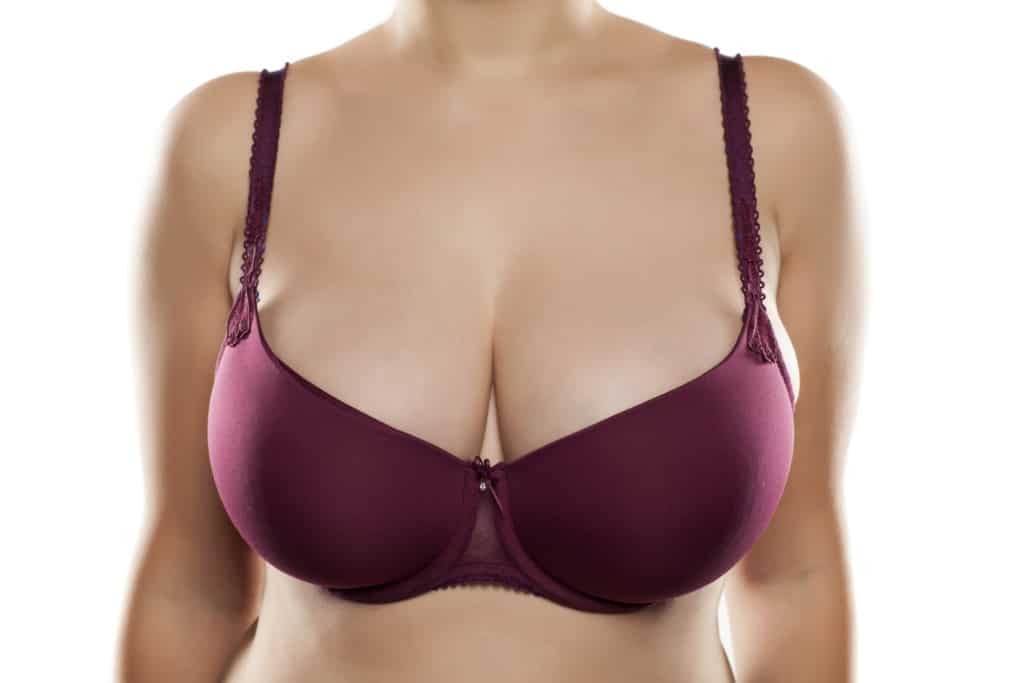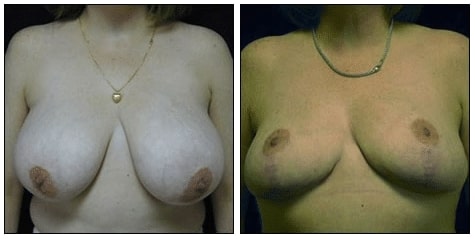Having overly large natural breasts can be a burden for a woman, physically and mentally. The weight can lead to back and neck pain and nerve damage. Posture is difficult. Clothing is impossible to find. And the undue attention your breasts attract can make you avoid social situations.

Breast reduction surgery with Dr. Rick Silverman will bring your breasts into proportion with the rest of your figure, and can be incredibly freeing emotionally. This procedure can make a huge change in your body image and self-confidence. To learn more, call {tel} to schedule a consultation.
What Is Breast Reduction Surgery?
Breast reduction is clinically known as reduction mammoplasty. There are two incision options to access and remove excess glandular tissue, fat, and skin to reduce the overall size of the breasts. The breasts are brought up to a higher position on the chest, not unlike a breast lift, and the nipple/areola complex is repositioned. In most cases, Dr. Silverman also reduces the size of the areolae.

Why Would A Woman Consider A Breast Reduction?
Very large breasts can truly be a burden, both literally and figuratively. They can cause a number of physical and psychological problems for a woman. Here are some specific examples that could point toward the need for breast reduction:
- Backaches
- Neck pain
- Headaches and migraines
- Carpal tunnel syndrome
- Spinal problems
- Tingling in the hands
Having overly large breasts (the clinical term is hypermastia) can keep a woman from participating in sports and certain types of exercise. Plus, self-consciousness can impact many aspects of her professional and social life. If these issues sound like what you are experiencing, a breast reduction could be the answer. Call {tel} to schedule a consultation with Boston Plastic Surgeon, Dr. Rick Silverman.
How Does Dr. Silverman Perform A Breast Reduction?
Breast reduction surgery is performed with the patient under general anesthesia and takes from two to four hours. There are two typical incision types. The option used by Dr. Silverman will depend on the extent of sagging skin that needs to be addressed.
Traditional Incision Breast Reduction
In this method, Dr. Silverman creates an anchor-shaped incision that circles the areola, runs down to the breast crease, and follows the breast crease a few inches in each direction. This incision is normally used for women with extremely large breasts.
Vertical Incision Breast Reduction
The incision here is more like a lollipop, circling the areola and running straight down to the breast crease. This is used for women with moderately large breasts and creates a smaller scar than the traditional method.
In both cases, fat, excess glandular tissue, and skin are removed. The nipples and areolae are usually relocated to a higher position, as well. The areolae will likely be made smaller.
Should I Lose Weight Before the Breast Reduction?
If you have any inclination to lose 25 pounds or more, it is ideal to do so before having breast reduction surgery. If you have a breast reduction and then lose more than 10 to 15 pounds, there is a chance that your breasts will deflate and become droopy.
Do You Recommend Having a Breast Reduction Before Having Kids or After?
Generally, we recommend having breast reduction surgery after having children, not before. That said, there is room for options. During your consultation with Dr. Silverman, you can discuss how future pregnancy and breastfeeding may affect the outcome of your procedure. There is no reason not to explore your options for breast contouring even if you plan to have children in the future. In most cases, women who have breast reduction surgery can breastfeed later if they would like. This must be a prominent topic discussed during the consultation so the maximum amount of glandular tissue can be preserved during the breast reduction procedure. That said, it is important to understand that there is a slight risk of disruption to the milk glands that could make breastfeeding difficult. Additionally, there are concerns related to the cosmetic effects that pregnancy and breastfeeding can have on the breasts, even after reduction surgery.
Does a Breast Reduction Decrease the Risk of Breast Cancer?
Multiple studies have shown that women who undergo breast reduction surgery do experience a reduced risk of breast cancer. The reduction is actually pretty significant, between 50 and 70 percent. The reasoning is simple. Breast cancer usually arises from dead cells in the fatty tissue of the breasts. When there is less fatty tissue, there are fewer cells that may manifest into cancer.
Can Breast Reduction Be Combined with Other Procedures?
Yes. Combining breast reduction with other breast or body contouring procedures can accentuate your shape beautifully. The most common option is a breast reduction with a breast lift. However, there are situations in which a woman wants to undergo breast reduction with implants, usually to reduce a known cancer risk. Other procedures that can be combined with a breast reduction to enhance the results include liposuction, abdominoplasty, and other forms of body contouring. Talk to Dr. Silverman about your overall goals for your shape and your sense of confidence. That discussion can prove to be very fruitful when it comes to developing your ideal treatment plan.
Are You a Good Candidate for a Breast Reduction?
There are a few factors that the doctor evaluates to determine if a patient is a good candidate for surgery. Ideal breast reduction patients share a few traits. These include:
- Adverse physical symptoms caused by heavy breasts. Examples include back and neck pain and indentations from bra straps.
- Avoidance of smoking and tobacco use. If you smoke, you can safely undergo breast reduction surgery if you quit the habit several weeks before surgery.
- Good physical and emotional health. Expect a thorough review of your medical history during your intake visit. This is done to ensure your safety and optimal outcome.
- A personal desire to enhance shape via breast reduction. Surgery should be done only for oneself, not for others.
- Realistic expectations. There are limitations to how much the breasts can be reduced. Removing too much tissue can lead to complications such as disrupted blood supply to the nipple.
Is There Scarring After Reduction Mammoplasty?
This procedure involves a sizable incision and thus will create scarring. Your incision scars will be pink for a few weeks, and then they will begin to lighten. They will always be there, but their appearance will continue to improve with time.
The best advice for managing or attempting to minimize the appearance of your scars is to leave the steri-strips in place until Dr. Silverman removes them at your follow-up. Also, wearing your surgical bra and then your support bra at all times during the first 4-6 weeks is critical. This eliminates any pressure on the incisions, which keeps the scars as narrow as possible. It also helps eliminate some of the redness.
Keep your scars out of the sun. Healing skin is extra sensitive, plus sun exposure makes scars darken. A product called bioCorneum+ SPF 30 is a good topical silicone treatment that doubles as a sunscreen. It creates an invisible protective layer over the scar. This keeps it clean, supported, and shielded from UV rays.
Dr. Silverman can recommend topical scar-minimizing treatments that keep the area moisturized and help to minimize the appearance of the scars. SkinMedica makes one such product called Scar Recovery Gel with Centelline.
Lightly massaging your scars can help them heal more smoothly. But you cannot do this too early and put stress on your incisions. Ask Dr. Silverman when massage could be appropriate, along with the proper technique.
What Is Recovery Like After Breast Reduction Surgery?
You will have soreness, swelling, and bruising because breast reduction involves a fair amount of tissue trauma. After two days, your bandages will be removed and replaced by a surgical bra. Dr. Silverman stresses the importance of wearing this surgical bra (and then transitioning to a support bra) for 24 hours a day. This removes any weight and pressure on your incisions. You’ll have to take it easy for the first one to two weeks, and avoid strenuous activity for probably six weeks. You’ll need to take at least one, and more likely two weeks off of work. Dr. Silverman is often able to maintain nipple sensation and breastfeeding function after breast reduction, but this is not always possible.
Tips For Successful Recovery From Breast Reduction Surgery
Due to the size of the incisions involved with breast reduction and the amount of tissue trauma, recovery isn’t a walk in the park. Here are a few tips to make it go more smoothly.
- Get help — For the first two to three days after your surgery, you’ll need someone with you to help you get around, cook meals, handle household chores, help with the kids, and keep you from having to lift anything.
- Follow your post-op instructions — Our team will give you detailed recovery instructions, and you need to follow them completely. These are areas such as removing bandages, bathing, exercise, driving, and the like.
- Eat well — Your healing body needs good nutrition to help with the healing process. High protein foods are good.
- Wear your surgical bra — Supporting your downsized breasts is critical to improve circulation (and healing), to reduce scar formation, to minimize movement (and pain), to prevent the development of sagging skin, and to minimize swelling.
- Take it easy — You may be so thrilled to not have your large breasts getting in the way that you want to get out and do stuff. For the first two weeks, it’s a far better idea to lay low and let your body get down to the business of healing. Have friends or your spouse do things like grocery shopping and vacuuming.
- Patience is not only a virtue, but a necessity — This isn’t an instant recovery. Full recovery after breast reduction will likely take at least six months and could need up to a year. There will be residual swelling and sensitivity. Your breasts can slightly change shape as the tissues adjust and heal. Your scars will be quite visible in the beginning. But if you think long-term and how happy you’ll be to have breasts that are proportional to your figure and not such a burden to everyday life, then your recovery will be manageable.
Schedule A Breast Reduction Consultation In Worcester
Ready to take the next step in learning more about reducing the size of your breasts? Call {tel} to schedule a consultation with Dr. Silverman. You can also fill out the form in our contact page, and our talented team will help you set up your appointment. Our practice looks forward to serving you!

